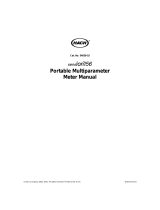
Instruction Manual DO 6+
Table of Contents
1. INTRODUCTION ...............................................................1
2. GETTING STARTED.........................................................2
2.1 Description of Keypad Functions ...................................................................2
2.2 Description of LCD Annunciators...................................................................3
2.3 Inserting & removing the rubber armour / stand.............................................4
2.4 Inserting New Batteries.................................................................................4
2.5 Battery Replacement .....................................................................................5
2.6 Connecting the Electrode...............................................................................5
2.7 Electrode Information.....................................................................................6
2.8 Switching the Meter On .................................................................................7
2.9 Changing Mode .............................................................................................7
3. CALIBRATION..................................................................8
3.1 General Information .......................................................................................8
3.2 Temperature Calibration ................................................................................10
3.3 % Saturation Calibration ................................................................................11
3.3.1 100% Calibration ...............................................................................11
3.3.2 0% Calibration ...................................................................................12
3.4 mg/L or ppm Calibration ................................................................................13
4. MEASUREMENT ..............................................................14
4.1 Temperature Compensation ..........................................................................14
4.2 Taking Measurements ...................................................................................15
4.3 Pressure & Salinity Compensated Measurements .........................................16
4.4 Holding a Reading .........................................................................................16
5. SETUP...............................................................................17
5.1 Configuration Menu (COF.1)..........................................................................21
5.2 Automatic Temperature Compensation (A.ATC)............................................21
5.3 Selection of mg/L or ppm (b.DO) ...................................................................22
5.4 Calibration Data (CAL.2)................................................................................22
5.5 Electrode Data (ELE.3)..................................................................................23
5.6 Automatic Shut Off (AtO.4) ............................................................................24
5.7 Reset to Factory Default (rSt.5) .....................................................................25
5.8 % Saturation Offset Adjustment (OFS.6) .......................................................26
5.9 Pressure & Salinity Adjustment......................................................................27
6. PROBE MAINTENANCE ..................................................29
6.1 Cap and Electrolyte Replacement..................................................................30
6.2 Electrolyte Solution........................................................................................31
7. TROUBLESHOOTING ......................................................31
8. ERROR MESSAGES ........................................................32





















